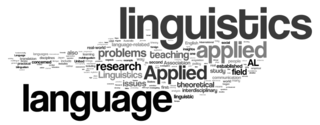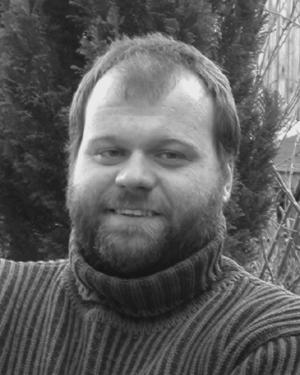Speech recognition is an interdisciplinary subfield of computer science and computational linguistics that develops methodologies and technologies that enable the recognition and translation of spoken language into text by computers with the main benefit of searchability. It is also known as automatic speech recognition (ASR), computer speech recognition or speech to text (STT). It incorporates knowledge and research in the computer science, linguistics and computer engineering fields. The reverse process is speech synthesis.
In sociolinguistics, a variety, also called an isolect or lect, is a specific form of a language or language cluster. This may include languages, dialects, registers, styles, or other forms of language, as well as a standard variety. The use of the word "variety" to refer to the different forms avoids the use of the term language, which many people associate only with the standard language, and the term dialect, which is often associated with non-standard varieties thought of as less prestigious or "correct" than the standard. Linguists speak of both standard and non-standard (vernacular) varieties. "Lect" avoids the problem in ambiguous cases of deciding whether two varieties are distinct languages or dialects of a single language.

The Wu languages is a major group of Sinitic languages spoken primarily in Shanghai, Zhejiang Province, and the part of Jiangsu Province south of the Yangtze River, which makes up the cultural region of Wu. The Suzhou dialect was the prestige dialect of Wu as of the 19th century, and formed the basis of Wu's koiné dialect, Shanghainese, at the turn of the 20th century. Speakers of various Wu languages sometimes inaccurately labelled their mother tongue as "Shanghainese" when introduced to foreigners. The languages of Northern Wu are mutually intelligible with each other, while those of Southern Wu are not.

Forensic linguistics, legal linguistics, or language and the law, is the application of linguistic knowledge, methods, and insights to the forensic context of law, language, crime investigation, trial, and judicial procedure. It is a branch of applied linguistics.

Christopher "Monty" Montgomery is an American programmer. He is the original creator of the Ogg Free Software container format and the Vorbis audio codec and others, and the founder of The Xiph.Org Foundation, which promotes public domain multimedia codecs. He uses xiphmont as an online pseudonym.
STUDENT is an early artificial intelligence program that solves algebra word problems. It is written in Lisp by Daniel G. Bobrow as his PhD thesis in 1964. It was designed to read and solve the kind of word problems found in high school algebra books. The program is often cited as an early accomplishment of AI in natural language processing.
Linguistics is the scientific study of human language. It is called a scientific study because it entails a comprehensive, systematic, objective, and precise analysis of all aspects of language, particularly its nature and structure. Linguistics is concerned with both the cognitive and social aspects of language. It is considered a scientific field as well as an academic discipline; it has been classified as a social science, natural science, cognitive science, or part of the humanities.
Speaker diarisation is the process of partitioning an audio stream containing human speech into homogeneous segments according to the identity of each speaker. It can enhance the readability of an automatic speech transcription by structuring the audio stream into speaker turns and, when used together with speaker recognition systems, by providing the speaker’s true identity. It is used to answer the question "who spoke when?" Speaker diarisation is a combination of speaker segmentation and speaker clustering. The first aims at finding speaker change points in an audio stream. The second aims at grouping together speech segments on the basis of speaker characteristics.
Carole Elisabeth Chaski is a forensic linguist who is considered one of the leading experts in the field. Her research has led to improvements in the methodology and reliability of stylometric analysis and inspired further research on the use of this approach for authorship identification. Her contributions have served as expert testimony in several federal and state court cases in the United States and Canada. She is president of ALIAS Technology and executive director of the Institute for Linguistic Evidence, a non-profit research organization devoted to linguistic evidence.

Peter Balazs is an Austrian mathematician working at the Acoustics Research Institute Vienna of the Austrian Academy of Sciences.
The Integrational theory of language is the general theory of language that has been developed within the general linguistic approach of integrational linguistics.
The Medical Intelligence and Language Engineering Laboratory, also known as MILE lab, is a research laboratory at the Indian Institute of Science, Bangalore under the Department of Electrical Engineering. The lab is known for its work on Image processing, online handwriting recognition, Text-To-Speech and Optical character recognition systems, all of which are focused mainly on documents and speech in Indian languages. The lab is headed by A. G. Ramakrishnan.

An audio coding format is a content representation format for storage or transmission of digital audio. Examples of audio coding formats include MP3, AAC, Vorbis, FLAC, and Opus. A specific software or hardware implementation capable of audio compression and decompression to/from a specific audio coding format is called an audio codec; an example of an audio codec is LAME, which is one of several different codecs which implements encoding and decoding audio in the MP3 audio coding format in software.
Sinsy (しぃんしぃ) is an online Hidden Markov model (HMM)-based singing voice synthesis system by the Nagoya Institute of Technology that was created under the Modified BSD license.
Bing Liu is a Chinese-American professor of computer science who specializes in data mining, machine learning, and natural language processing. In 2002, he became a scholar at University of Illinois at Chicago. He holds a PhD from the University of Edinburgh (1988). His PhD advisors were Austin Tate and Kenneth Williamson Currie, and his PhD thesis was titled Reinforcement Planning for Resource Allocation and Constraint Satisfaction.

In Western music, the term chroma feature or chromagram closely relates to the twelve different pitch classes. Chroma-based features, which are also referred to as "pitch class profiles", are a powerful tool for analyzing music whose pitches can be meaningfully categorized and whose tuning approximates to the equal-tempered scale. One main property of chroma features is that they capture harmonic and melodic characteristics of music, while being robust to changes in timbre and instrumentation.
Multimodal sentiment analysis is a new dimension of the traditional text-based sentiment analysis, which goes beyond the analysis of texts, and includes other modalities such as audio and visual data. It can be bimodal, which includes different combinations of two modalities, or trimodal, which incorporates three modalities. With the extensive amount of social media data available online in different forms such as videos and images, the conventional text-based sentiment analysis has evolved into more complex models of multimodal sentiment analysis, which can be applied in the development of virtual assistants, analysis of YouTube movie reviews, analysis of news videos, and emotion recognition such as depression monitoring, among others.
Emotion recognition in conversation (ERC) is a sub-field of emotion recognition, that focuses on mining human emotions from conversations or dialogues having two or more interlocutors. The datasets in this field are usually derived from social platforms that allow free and plenty of samples, often containing multimodal data. Self- and inter-personal influences play critical role in identifying some basic emotions, such as, fear, anger, joy, surprise, etc. The more fine grained the emotion labels are the harder it is to detect the correct emotion. ERC poses a number of challenges, such as, conversational-context modeling, speaker-state modeling, presence of sarcasm in conversation, emotion shift across consecutive utterances of the same interlocutor.
The audio deepfake is a type of artificial intelligence used to create convincing speech sentences that sound like specific people saying things they did not say. This technology was initially developed for various applications to improve human life. For example, it can be used to produce audiobooks, and also to help people who have lost their voices to get them back. Commercially, it has opened the door to several opportunities. This technology can also create more personalized digital assistants and natural-sounding speech translation services.
Ani Nenkova is Principal Scientist at Adobe Research, currently on leave from her position as an Associate Professor of Computer and Information Science at the University of Pennsylvania. Her research focuses on computational linguistics and artificial intelligence, with an emphasis on developing computational methods for analysis of text quality and style, discourse, affect recognition, and summarization.





